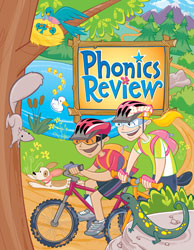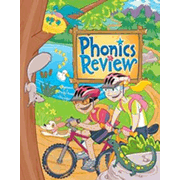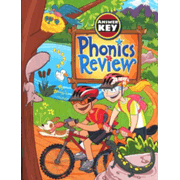Phonics Review might be used with children in second or third grade who have already had some phonics instruction, but who need review and reinforcement. It might also be used with ESL students or older students who might have received spotty instruction in phonics. It moves much too quickly for younger students who are just learning to read.
It skips the introduction to the alphabet and how to blend letters into words, assuming that content will have already been taught. Lessons begin with identification of initial and final consonants in words. While a book for younger students would use three-letter words for such lessons, Phonics Review used lengthier, more complex words such as trash and triangle. Consonant blends are also covered in the first unit.
The next two units review short vowels and long vowels, respectively. The fourth unit covers other vowel sounds. Unit five deals with suffixes and prefixes. The sixth and final unit is a grab bag covering concepts such as the phonograms dge and tch, homophones, synonyms, antonyms, and contractions. The last five units each include a small storybook for reading practice, a storybook that is created by removing and folding a page from the worktext.
While some exercises require students to simply check the correct answer or match columns, many exercises direct students to fill in the blanks and write complete words. Occasional pages include writing prompts for students to write a paragraph.
The 258-page worktext is illustrated in full color with a font size and writing lines that should work well for students who have already learned to print or write. While they are still relatively large, they are smaller than we usually see in kindergarten and first grade phonics workbooks since Phonics Review assumes students have already been practicing handwriting and have developed enough control to write on smaller lines.
Instructions are included in the worktext so students can work independently. However, struggling readers might need assistance to read the instructions. A Phonics Review Student Answer Key is available, but answers should be obvious to most parents or teachers, so the answer key is not essential. However, one exercise on page 188 assumes student familiarity with stories from the Old Testament, and parents, likewise, might need to know about Adam and Eve, the Red Sea, David, Naaman, and Jonah or else they will need to check the answers with the answer key. While this makes it sound like there could be a lot of biblical content in Phonics Review, Christian and biblical content is actually very limited.
While there are other phonics workbooks that can be used both for those just learning to read and for review and remediation, Phonics Review nicely condenses the essentials into a single book that is easy to use while still providing thorough coverage and plenty of practice.










